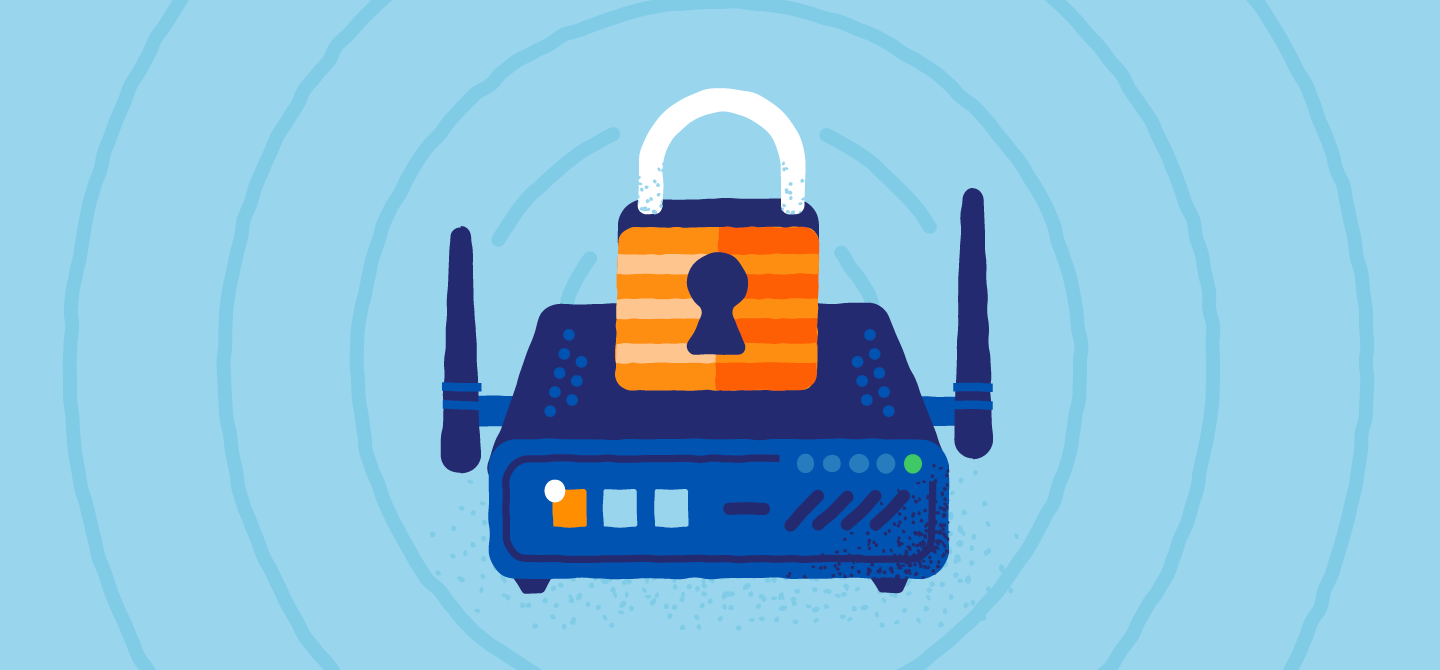Wireless networks are everywhere. Whether you’re at a local coffee shop, a school or at home, it’s likely there are multiple wireless networks you can gain access to. But how do you know which ones are safe? Looking at the network security settings can be a good indicator of which ones you can trust. To help you understand your options, we discuss the history of security protocols and compare WPA vs. WPA2.
Wi-Fi Router Security Options
When you install Wi-Fi, you have a few router security options. Wireless networks are more vulnerable to cyberattacks compared to wired networks. If your router is unsecured, someone could access it, use it for illegal activities in your name, track your internet use or even install malware. To keep you safe while browsing, some wireless networks have security protocols that encrypt your online data. When you look at a wireless network’s security, a few options will be available. These choices will include none, WEP, WPA, WPA2-Personal, WPA2-Enterprise and possibly WPA3. Depending on the nature of your online use, you may require more or less security.

What’s the Best Wireless Internet Security Method?
What security method you choose will depend on the capabilities of your router. Older devices aren’t able to support newer security protocols like WPA3.
If you have the option, here is the list of the best security protocols, ordered from most secure to least secure:
- WPA3
- WPA2 Enterprise
- WPA2 Personal
- WPA + AES
- WPA + TKIP
- WEP
- Open Network (no security implemented)
What Is WEP (Wired Equivalent Privacy)?
Wireless security has evolved over time to get stronger and easier to configure. Since the beginning of WiFi, we’ve transitioned from WEP protocol to WPA3 protocol. Read through to learn about the history of how these security protocols evolved.
![]()
The first security protocol was named Wired Equivalent Privacy, or WEP. It was the standard protocol from 1999 to 2004. While this version was made to protect against data breaches, it had poor security and was hard to configure.
Cryptographic technology imports were restricted at the time, meaning that more manufacturers could only use 64-bit encryption. This is a very low-bit encryption compared to the 128-bit or 256-bit options available today. Ultimately, WEP was abandoned for a more advanced solution.
WEP Pros and Cons
- Pros
- A form of security
- First model to secure Wi-Fi
- Cons
- Poor configuration
- Lack of security
- Limited encryption
- Outdated
Systems that still use WEP aren’t secure. If you have a system with WEP, it should be upgraded or replaced. Or if you’re connecting to Wi-Fi at an establishment that has WEP, your internet activity will not be secure.
What Is WPA (Wi-Fi Protected Access)?
![]()
To improve the functions of WEP, Wi-Fi Protected Access, or WPA, was created in 2003. This temporary enhancement still has relatively poor security but is easier to configure. WPA uses the Temporal Key Integrity Protocol (TKIP) for more secure encryption than WEP offers.
As the Wi-Fi Alliance made this transition to a more advanced protocol, they had to keep some of the same elements of WEP so older devices would still be compatible. Unfortunately, this means vulnerabilities are still present in the updated version of WPA, such as the Wi-Fi Protected Setup feature, which can be hacked relatively easily.
WPA Pros and Cons
Consider the following benefits and drawbacks of WPA before choosing a Wi-Fi security method.
- Pros
-
- Better security than WEP
- Easy configuration
- Backwards compatibility with earlier WEP systems
- TKIP data encryption
- Cons
-
- Security vulnerabilities
- Compatible with WEP devices
- Outdated
What Is WPA2 (Wi-Fi Protected Access 2)?
![]()
Wi-Fi Protected Access 2 (WPA2) was released in 2004 and provides a higher level of security than its predecessors. WPA2 limits access without a network password and protects sensitive data using the Advanced Encryption Standard (AES) instead of TKIP.
It comes in two forms: WPA2-Personal for general use with a single password and WPA2-Enterprise for individual passwords per device, suitable for corporations. However, a vulnerability exists in WPA2. Once inside the network, an attacker can compromise other connected devices, which creates a risk for internal threats in organizations.
If the router is compatible with WEP systems, WPA2 is still vulnerable to WEP attacks. Disable WEP on your router and ensure your device isn’t running WEP software to stop these attacks.
WPA2 Pros and Cons
WPA2 is undoubtedly a step up from WPA. Review the following benefits and drawbacks of this security method to make the most informed decision.
- Pros
-
- Advanced encryption security
- Government security standard model
- 256-bit encryption key
- User authentication
- Cons
-
- May not be compatible with all devices
- Not completely protected against vulnerabilities
WPA vs. WPA2: How Are They Different?
WPA and WPA2 are the most common security measures used to protect wireless internet. We’ve compared the difference between WPA vs. WPA2 so you can find the right option for your situation.
| WPA | WPA2 | |
| Year it became available | 2003 | 2004 |
| Encryption method | Temporal Key Integrity Protocol (TKIP) | Advanced Encryption Standard (AES) |
| Security strength | Stronger than WEP, offers basic security | Stronger than WPA, offers increased security |
| Device support | Can support older software | Only compatible with newer software |
| Password length | Shorter password required | Longer password required |
| Business usage | No enterprise solutions | Has enterprise option |
| Processing power required | Minimal needed | Significant amount needed |
When comparing WPA vs. WPA2, WPA2 is going to be the best option if your device can support it.
What Is WPA3 (Wi-Fi Protected Access 3)?
![]()
The Wi-Fi Alliance released WPA3 after identifying flaws in WPA2. As the most recent Wi-Fi security update, WPA3 offers enhanced cryptographic strength for extremely sensitive data markets and more reliable authentication. Since WPA3 is still not widely available to the general public, most people cannot purchase hardware that has earned a WPA3 certification.
WPA3 Pros and Cons
WPA3 is more advanced than WPA and WPA2, but there’s more to know about this method than that. Be aware of the following pros and cons as you make your decision.
- Pros
-
- Advanced security beyond WPA2
- Stronger protection against hackers
- Improved user authentication
- Replaces previous versions that used a pre-shared key
- 256-bit encryption
- Cons
-
- Poor device support and compatibility
- Higher cost
- Not 100% hacker-proof
Wi-Fi Tools for Stronger Security
WPA3 is the latest for Wi-Fi security protocols and ensuring you stay protected online. Nevertheless, there are still some vulnerabilities in the most recent update. For better protection against hackers and cyberattacks and to remain anonymous on the internet, it’s best to invest in additional Wi-Fi security features and encryption tools.
Some of these tools include a VPN, which encrypts your IP address from hackers, or private search engines like DuckDuckGo, which shield your online activity from third-party cookie trackers. These tools use Wi-Fi security protocols to encrypt sensitive information and prevent data breaches.
FAQ
Whether you’re using a home Wi-Fi router or managing a corporate network, Wi-Fi security protocols ensure your data remains secure. Below are some commonly asked questions about WPA vs. WPA2 vs. WPA3.
What Is the Weakness of WPA2?
If your router is compatible with the earlier version of WEP, WPA2 is vulnerable to cyberattacks via this software. Disable WEP from your router network to fix this problem. Another issue is that a person connected to a WPA2 network can also attack other devices connected to the same network.
Should I Use WPA, WPA2 or WPA3?
Compared to WEP or WPA2, the most recent Wi-Fi security protocol, WPA3, offers more sophisticated encryption features. Not all devices are compatible with WPA3, so if your device or router supports it, it should be your preferred security option. Most devices are compatible with WPA2, making it the next best software.
Is WPA2 Backwards Compatible With WPA?
WPA2 is backwards compatible with WPA, which functions with older software versions. WPA and WPA2 can enhance router security when used together. WPA2 employs AES encryption, while WPA verifies users’ initial login credentials using pre-shared keys. But be cautious when using these two systems at once, since hackers can exploit the security flaws in WPA and breach your data.
Can I Switch From WPA2 to WPA3?
Although it is possible, switching from WPA2 to WPA3 is difficult because of WPA3’s stronger encryption standard. Adopting WPA3 would require networks to significantly update their hardware, which could be more expensive than sticking with WPA2 or other older models.
Upgrade Your Wi-Fi With Panda Security
WPA2 should always be your go-to option when comparing WPA vs. WPA2.
Upgrade your Wi-Fi security with the latest application for your routers, PCs and mobile devices. Doing this can prevent someone from stealing your personal information and give you greater peace of mind when using public networks. Since Wi-Fi security is constantly changing, monitoring activity on your network is critical to keeping hackers out. Get a free Panda Security trial to safeguard your devices and improve your home’s security.
Sources:






3 comments
how do i know if my router is wpa or wpa2? -it’s a motoralanvg510
You will need to access the router contro panel and go to security tab. Find the password area and see what kind of encryption you using
Your article effectively educates readers on the importance of staying updated on security measures for wireless networks. Thank you for informative!